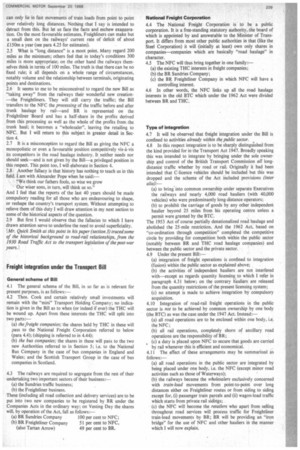Type of integration
Page 213

If you've noticed an error in this article please click here to report it so we can fix it.
4.7 It will be observed that freight integration under the Bill is confined to activities already within the public sector.
4.8 In this respect integration is to be sharply distinguished from the kind provided for in the Transport Act 1947. Broadly speaking this was intended to integrate by bringing under the sole ownership and control of the British Transport Commission all longdistance traffic whether by road or rail. Originally it had been intended that C-licence vehicles should be included but this was dropped and the scheme of the Act included provisions (inter alia):— (a) to bring. into common ownership under separate Executives the railways and nearly 4,000 road hauliers (with 40,000 vehicles) who were predominantly long-distance operators;
(b) to prohibit the carriage of goods by any other independent haulier beyond 25 miles from his operating centre unless a permit were granted by the BTC.
The 1953 Act of course partially denationalized road haulage and abolished the 25-mile restriction. And the 1962 Act, based on "co-ordination through competition" completed the competitive circle by providing for competition both within the public sector (notably between BR and THC road haulage companies) and between the public sector and the private sector.
4.9 Under the present Bill:— (a) integration of freight operations is confined to integration (fusion) within the public sector as explained above; (b) the activities Of independent hauliers are not interfered with—except as regards quantity licensing to which I refer in paragraph 4.31 below; on the contrary liauliers are released from the quantity restrictions of the present licensing system; (c) no attempt is made to achieve integration by compulsory acquisition.
4.10 Integration of road-rail freight operations in the public sector is not to be achieved by common ownership by one body (the BTC) as was the case under the 1947 Act. Instead:—
(a) all road operations are to be enclosed within one body, i.e. the NFC; (b) all rail operations, completely shorn of ancillary road operations are the responsibility of BR; (c) a duty is placed upon NFC to secure that goods are carried by rail whenever this is efficient and economical.
4.11 The effect of these arrangements may be summarized as follows:—
(a) all road operations in the public sector are integrated by being placed under one body, i.e. the NFC (except minor road activities such as those of Waterways);
(b) the railways became the wholesalers exclusively concerned with train-load movements from point-to-point over long distances either on Freightliner routes or from siding to siding except for, (i) passenger train parcels and (ii) wagon-load traffic which starts from private rail sidings; (c) the NFC will become the retailers who apart from selling throughout road services will process traffic for Freightliner train-load movements by BR; BR will be providing an "iron bridge" for the use of NFC and other hauliers in the manner which I will now explain.


















































































































































































































































































































































































